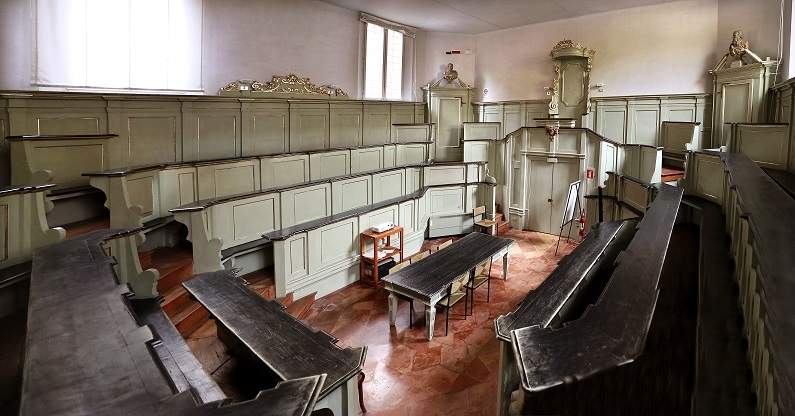Restoration of the Teatro Anatomico "Tumiati," an 18th-century room located inside Palazzo Paradiso, home of the Ariostea Library, began this week in Ferrara. The intervention began with an anti-wormwood treatment, which is the start of the preliminary work that in turn will precede the conservative restoration of the historic hall. The intervention was entrusted to a restorer from Ferrara, Alberto Sorpilli.
The pest control intervention against woodworm is being carried out by the Ravenna-based company Radis, which has sealed the interior wooden structures, the access door, window and door frames, using gummed paper, wood, and insulating tape. A cylinder containing carbon dioxide for two weeks will inject Co2 into the room saturating the environment and thus creating hostile conditions for woodworms. External sensors, connected to detection instruments in the room, will monitor temperatures and Co2 concentration, modulating the inflow from the cylinder from time to time. This will be followed by an antiworm spray, which will be left to work for another week, then seals and covers will be removed and the environmental remediation phase will begin, including the adoption of powerful fans. Overall, the entire preparatory phase of the restoration work will take about a month. At that point, the Ferrara-based restorer Sorpilli, with staff and personnel in charge, will begin their work, which will include the repair of the wooden structure by plastering any cracks, maintenance of the doors, consolidation of the wooden platforms and portions of the wood that are currently detached or raised, chromatic recovery of the plastering, harmonization of the silvering, which will be redone, and a final protective treatment. This second phase of work will last approximately thirty days. Therefore, by the end of June, the completion of the intervention is expected, barring unforeseen circumstances.
“The Teatro Anatomico is one of the great symbols of Ferrara’s important university tradition; it was prepared in 1731 and served its function until 1831, when the seat of the Faculty of Medicine was moved to the Arcispedale Sant’anna in Corso della Giovecca,” stresses Public Works Councillor Andrea Maggi, promoter of the intervention, financed with about 40 thousand euros donated by the historic Copma cooperative, which recently turned 50. “Thanks to Copma for making an extraordinary gift to the city.” adds Maggi, “A gift that demonstrates attention, sensitivity to the care and protection of the heritage and that has a particular historical value: in fact, Ferrara was among the ten Italian cities that, since 1600, were the historical seat of anatomical studies and in 1500 a great doctor from Ferrara, Giovan Battista Canano, was the forerunner of many scientific discoveries that inspired other eminent scholars of the following centuries.”
Pictured: the Anatomical Theater of Ferrara
 |
| Ferrara, start of the restoration of the Anatomical Theater of the Ariostea Library |
Warning: the translation into English of the original Italian article was created using automatic tools. We undertake to review all articles, but we do not guarantee the total absence of inaccuracies in the translation due to the program. You can find the original by clicking on the ITA button. If you find any mistake,please contact us.